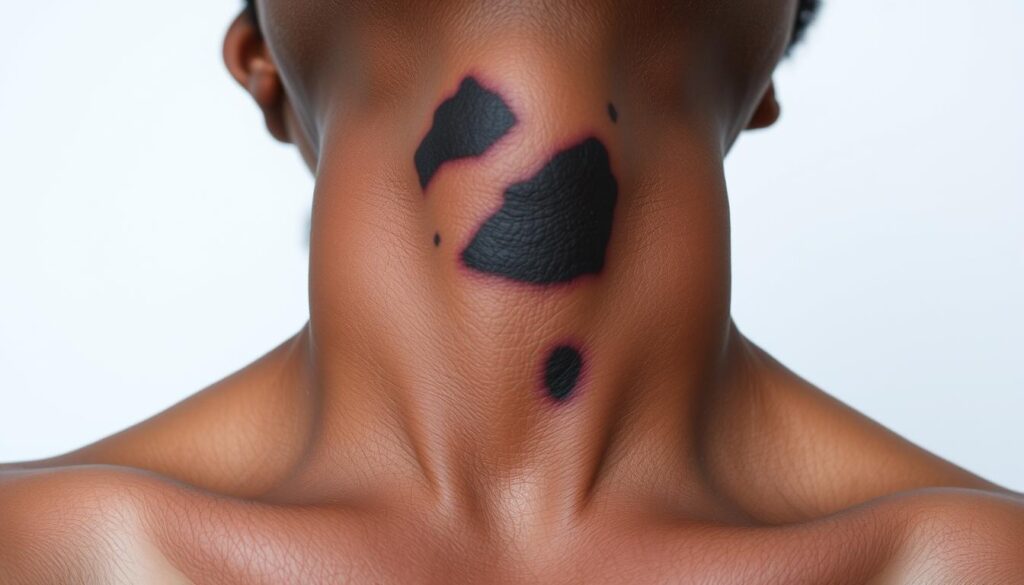Acanthosis nigricans is a unique skin condition that reveals insights about your health. It appears as velvety, dark patches in specific body areas. This skin change can signal potential underlying health issues1.
Your skin can indicate internal health processes. Acanthosis nigricans typically shows up in skin folds like the neck and armpits. It’s linked to insulin resistance, diabetes, and obesity1.
This condition is more than just a cosmetic concern. It can be a warning sign of metabolic problems2. Knowledge about acanthosis nigricans is your best defense against potential health risks.
The condition often develops in people with specific risk factors. These include being overweight or from certain ethnic backgrounds3. Understanding its causes and treatments can help you take steps towards better health.
Key Takeaways
- Acanthosis nigricans often indicates underlying metabolic conditions
- Skin changes can appear in neck, armpit, and groin areas
- Insulin resistance is a primary contributing factor
- The condition is more prevalent in certain ethnic groups
- Early detection can lead to better health management
What is Acanthosis Nigricans and Its Common Symptoms
Acanthosis nigricans is a skin condition with unique changes. It can reveal important clues about your overall health. This endocrine disorder creates distinct skin transformations4.
The condition affects specific groups more often. Native Americans, African Americans, and Hispanics have higher rates5. Your skin might develop velvety patches showing metabolic changes.
Key Physical Characteristics
Acanthosis nigricans presents several notable physical characteristics:
- Hyperpigmentation in skin folds
- Velvety patches with dark, thickened skin
- Typically appearing in neck, groin, and armpit regions
- Light brown or black skin discoloration
Early Warning Signs
Recognizing early signs can help you address potential health concerns:
- Gradual skin thickening
- Subtle skin texture changes
- Localized skin discoloration
“Skin changes can be windows to underlying health conditions”
About one-third of malignant cases show skin changes before cancer diagnosis4. Your body might be signaling important health information through these changes5.
| Characteristic | Description |
|---|---|
| Prevalence | Higher in specific ethnic groups |
| Common Locations | Neck, Groin, Armpits |
| Skin Texture | Velvety, Thickened Patches |
Understanding these signs can help you take proactive steps toward your health management.
Understanding the Various Types of Acanthosis Nigricans
Acanthosis nigricans has several distinct types, each with unique features and causes. Knowing these types can help you spot potential health issues linked to this skin condition.
- Obesity-associated acanthosis nigricans: This type is linked to high body mass index. It’s more common in Hispanic and Black people67. African Americans are 25 times more likely to get it than Europeans7.
- Familial acanthosis nigricans: This genetic type can show up at birth or in early childhood. It often involves changes in the FGFR3 gene7.
- Malignant acanthosis nigricans: This rare type is linked to cancer, usually stomach cancer6.
Studies show interesting facts about who gets this condition:
| Population Group | Prevalence of Acanthosis Nigricans |
|---|---|
| Native Americans | 34.2% |
| African Americans | Highest risk group |
| Hispanics | High prevalence |
| Caucasians | Lowest prevalence |
Treatment isn’t always needed for acanthosis nigricans. Fixing the main cause can often help manage it.
A doctor can give you advice based on your specific type. Their guidance can be very helpful.
Remember, knowing the different types of acanthosis nigricans early can help you act fast. This can be key for your health.
Conclusion
Treating acanthosis nigricans requires identifying underlying health issues. It often signals metabolic problems, especially insulin resistance8. Your treatment plan will vary based on the root cause9.
Diagnosis involves assessing skin features and metabolic screening. Patients with this skin condition often have insulin resistance and potential heart risks9. Your doctor may suggest topical treatments like retinoids or chemical peels8.
Some cases need systemic interventions for complex health issues. In rare cancer-related cases, treating the cancer can improve skin appearance10. Complete cure is challenging, but proactive management can reduce symptoms and health risks8.
FAQ
What exactly is Acanthosis Nigricans?
Is Acanthosis Nigricans a serious medical condition?
Who is most likely to develop Acanthosis Nigricans?
Can Acanthosis Nigricans be treated?
Are there different types of Acanthosis Nigricans?
What are the early warning signs of Acanthosis Nigricans?
Is Acanthosis Nigricans contagious?
Source Links
- What Is Acanthosis Nigricans? – https://www.webmd.com/skin-problems-and-treatments/acanthosis-nigricans-overview
- Acanthosis Nigricans (for Teens) – https://kidshealth.org/en/teens/acanthosis.html
- What Is Acanthosis Nigricans And How Do I Manage It? – https://www.healthline.com/health/acanthosis-nigricans
- Acanthosis Nigricans – StatPearls – NCBI Bookshelf – https://www.ncbi.nlm.nih.gov/books/NBK431057/
- Acanthosis Nigricans: Causes, Diagnosis, and Treatment – DermNet – https://dermnetnz.org/topics/acanthosis-nigricans
- Acanthosis nigricans – Symptoms, diagnosis and treatment – https://bestpractice.bmj.com/topics/en-us/424
- Acanthosis Nigricans: A practical approach to evaluation and management – https://escholarship.org/uc/item/7mf6g290
- Acanthosis Nigricans: An Updated Review – PubMed – https://pubmed.ncbi.nlm.nih.gov/36698243/
- A study of the association of acanthosis nigricans with subclinical atherosclerosis – https://ijdvl.com/a-study-of-the-association-of-acanthosis-nigricans-with-subclinical-atherosclerosis/
- Malignant acanthosis nigricans associated with prostate cancer: a case report – BMC Urology – https://bmcurol.biomedcentral.com/articles/10.1186/1471-2490-14-88
